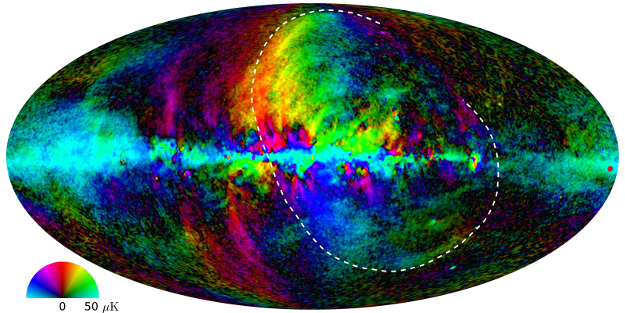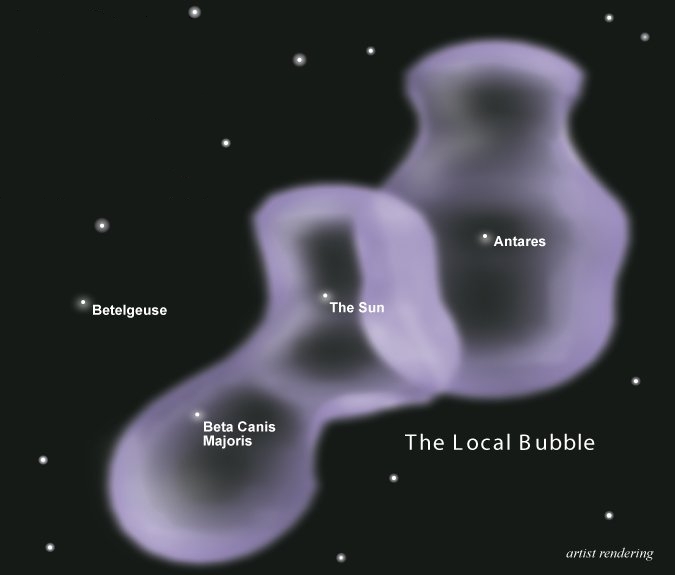Find out the latest thinking about our universe.
-
bystander
- Apathetic Retiree
- Posts: 21577
- Joined: Mon Aug 28, 2006 2:06 pm
- Location: Oklahoma
Post
by bystander » Tue Jun 07, 2016 8:51 pm
A Mysterious Ring of Microwaves
ESA Science & Technology | Planck | 2016 Jun 06
Fifty years ago, astronomers discovered a mystery. They called it Loop I. Today, we still have not fully resolved the mystery of how this giant celestial structure formed but we do now have the best image of it, thanks to ESA’s Planck satellite.
Loop I is a nearly circular formation that covers one third of the sky. In reality, it is probably a spherical ‘bubble’ that stretches to more than 100º across, making it wider than 200 full Moons. Its absolute size, however, is extremely uncertain because astronomers do not know how close it is to us: estimates to the centre of the bubble vary from 400 light-years to 25 000 light-years.
What they do know is that the structure shows up in many different wavelengths, from radio waves to gamma rays. Planck sees Loop I in microwaves. This image’s colours reflect the polarisation – the direction in which the microwaves are oscillating. ...
Rings and Loops in the Stars
Jodrell Bank Centre for Astrophysics | University of Manchester | 2016 Jun 06
Planck 2015 results. XXV. Diffuse low-frequency Galactic foregrounds - Planck Collaboration
Know the quiet place within your heart and touch the rainbow of possibility; be
alive to the gentle breeze of communication, and please stop being such a jerk. — Garrison Keillor
-
neufer
- Vacationer at Tralfamadore
- Posts: 18805
- Joined: Mon Jan 21, 2008 1:57 pm
- Location: Alexandria, Virginia
Post
by neufer » Wed Jun 08, 2016 2:24 pm
https://en.wikipedia.org/wiki/Local_Bubble wrote:
<<The Local Bubble is a cavity in the interstellar medium (ISM) in the Orion Arm of the Milky Way. It is at least 300 light years across and has a neutral-hydrogen density of about 0.05 atoms/cm
3, or approximately one tenth of the average for the ISM in the Milky Way (0.5 atoms/cm
3). The hot diffuse gas in the Local Bubble emits X-rays. It abuts other bubbles of less dense interstellar medium (ISM), including, in particular, the Loop I Bubble. From our Sun's point of view, the Loop I Bubble is situated towards the Galactic Center of the Milky Way galaxy and was created by supernovae and stellar winds in the Scorpius–Centaurus Association, some 500 light years from the Sun. The Loop I Bubble contains the star Antares (Alpha Scorpii), as shown on the diagram. (Other bubbles which are adjacent to the Local Bubble are the Loop II Bubble and the Loop III Bubble.)
The very sparse, hot gas of the Local Bubble is the result of supernovae that exploded within the past ten to twenty million years. It was once thought that the most likely candidate for the remains of this supernova was Geminga ("Gemini gamma-ray source"), a pulsar in the constellation Gemini. More recently, however, it has been suggested that multiple supernovae in subgroup B1 of the Pleiades moving group were more likely responsible, becoming a remnant supershell.
The Solar System has been traveling through the region currently occupied by the Local Bubble for the last five to ten million years. Its current location lies in the Local Interstellar Cloud (LIC), a minor region of denser material within the Bubble. The LIC formed where the Local Bubble and the Loop I Bubble met. The gas within the LIC has a density of approximately 0.1 atoms/cm
3.>>
Art Neuendorffer

